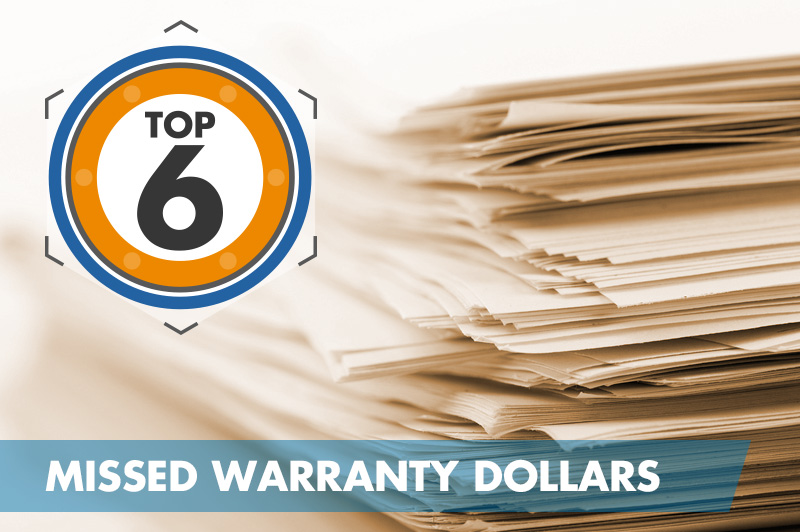The Top Six Missed Warranty Dollars

Based on observations during jlwarranty’s In-dealership Warranty Consultations and nationwide Warranty Administration Seminars, here are the Top Six reasons why dealerships miss available warranty dollars.
1.) ADMINISTRATIVE ALLOWANCE
Some warranty repairs qualify for administrative labor time paid to the dealership for their extra effort involved in the “paper work,” particularly with sublet repairs. In the LTG, sublet administrative time is identified under the labor operation as S1 & S2. S1 indicates that you are allowed to claim 0.2 additional labor hours. S2 implies you can claim up to 0.5 labor hours when your staff transports the customer’s vehicle to and from the sublet repair facility.
Other administrative allowance labor dollars include:
- 0.3 for tire warranty claims
- 0.2 for customer reimbursement claims
- 0.2 for personal property damage reimbursement
- 0.3 for returning requested parts to the Warranty Parts Center
- 0.2 for sending copies of job cards only, as directed by the WPC
- 0.2 handling allowance and $25 in net item for electronic exchange components
- Many bulletins that involve a part supplied by GM make an allowance for the handling, that can be submitted with the specific labor operation published in the bulletin.
Administrative time gets missed for a variety of reasons. While sublet administrative allowances are indicated in the LTG, new warranty administrators may never have been told what S1 and S2 mean. Even seasoned warranty administrators can overlook these coverage codes, especially if they hurry through the process of coding warranty claims. The other examples of administrative allowances listed above can be even tougher to remember as they aren’t done often and there are not coverage code reminders.
As with all knowledge gained in warranty processing, sharing with others is crucial if you want a successful warranty department. Share this article with everyone in your service department who codes claims, submits claims, checks in new vehicles, and creates damage codes.
2.) SHUTTLES
The Shuttle Stamp helps service advisors remember to collect all warranty revenue every time a shuttle or rental is provided.
Shuttle rides are included as one of the Top 6 missed warranty opportunities.
GM wants your dealership to minimize a mutual customer’s inconvenience when their vehicle is in your dealership for warranty repairs by helping out with transportation, but that transportation does not have to be a rental vehicle.
Your customers need to get to work, home, or wherever it is they need to be while their vehicle is in for service. That is why GM will reimburse your dealership for shuttle service to get your customer where they need to be. It is the preferred transportation alternative and you can be reimbursed $7 for providing a one-way shuttle and $15 for a two-way shuttle. Every warranty customer is entitled to a shuttle, regardless of the warranty repairs made to their vehicle. Amazingly very few dealerships claim shuttle reimbursement even though they are providing this service to their customers.
Again, you must educate your Service Advisors and make sure they are documenting on the job card that the customer received a shuttle ride. They are 100% responsible for putting shuttle documentation on the job card. If there is nothing written on the job card your warranty administrator will not know to claim it, therefore losing the money your dealership is due. Documenting shuttle rides on a job card could not be any easier. It is not necessary to open a line on the job card; all you need to do is write shuttle, or better yet, get a shuttle stamp and give one to each of your Service Advisors.
While $7 or $15 may not seem like a lot of money, multiply that by the number of customers you shuttled in a week and you may change your mind. Ten missed two-way shuttles a week is $150 left unclaimed.
3.) RECALLS
Recalls are one of several field action types that GM implements to address specific product concerns or regulatory requirements. The most common recalls are:
- Safety Recalls
- Noncompliance Recalls
- Emission Recalls
- Customer Satisfaction Programs
- Special Coverage Adjustment
- Service Update Bulletin
The actual category your customer’s recall falls under is relatively unimportant to your dealership; your responsibility is to complete these important service events when your customer brings their vehicles into your dealership. Sometimes your customers will make you aware of the recall and sometimes it is you who will make your customer aware. When your service advisors log onto GM GlobalConnect and view a GM IVH of their customer’s vehicle, any open recalls will appear under the heading “Required Field Actions” and should be performed.
Recalls are included in our Top 6 Missed Warranty Dollar Opportunities because too many times service advisors do not check GM IVH for open recalls when a vehicle is in for service.
From the GM Service Policies and Procedures manual: “All unsold new vehicles in dealers’ possession and subject to a product field action must be held and inspected/repaired per the service procedure of the product field action bulletin before customers take possession of these vehicles.”
Whenever a vehicle subject to a product field action enters your vehicle inventory, or is in the dealership for service in the future, you must take the steps necessary to be sure the correction has been made before selling or releasing the vehicle. This includes Canadian sold vehicles and warranty blocked or salvaged title vehicles.
Service advisors must check GM IVH on every vehicle that enters your service department and look for open recalls. If there is an open recall, print the summary page and attach it to the job card, contact the customer for permission to do the recall on their vehicle, add the repair line to the job card, and perform the recall.
4.) NEW VEHICLE PREPS
All new vehicles delivered to the dealership must be inspected and prepped before sale to the customer. GM will pay your dealership for this service; in fact, you are paid automatically through an auto pay process. The credit you get will appear on your transaction summary and you are often credited before you even receive the vehicle. Note: there are occasions when the auto pay process doesn’t happen; always check GM IVH for the status of your PDI payments. You can submit 0590072 with transaction type ZPDI if you were not paid for an eligible prep. The labor time can be found in the Labor Time Guide.
In June, 2004, GM revised the PDI auto pay process. Dealers are currently reimbursed through the auto pay process for the base time to prep the vehicle. Any accessories that were to be installed as part of the prep are submitted with transaction type ZPDI and labor operation 0590032. Fluid adds at time of prep are submitted with labor operation 0590052, transaction type ZPDI.
This money goes unclaimed primarily because the technician who performs the prep fails to indicate on the job card that a particular accessory was installed. It’s important that you tell your prep technicians that in addition to filling out the PDI form and documenting the inspection completion on the job card, they must also indicate any accessories that were installed on the vehicle or fluids that were added. The accessories may be shipped with the vehicle or shipped to the dealership ahead of time.
Another way to catch all accessory “adds” is to look up labor operation 0590032 in your LTG for each vehicle you are closing out a prep job card on. The labor operation will state each accessory that may be applicable to the vehicle and you can ask your technician if any of these accessories were installed. You can also check GM IVH and click on “vehicle build” and look for the words ***dealer installed*** at the end of the RPA code and description.
If claiming accessory or fluid add time is new information to you and you haven’t claimed them, you can go back and check your prep claims and submit for these dollars, if applicable, but only up to the 60 day time limit.
5.) PARTS EXPEDITING
Before we discuss why Parts Expediting is a missed dollar opportunity, let’s go over the basics of the program.
Parts expediting is described as a tool to help achieve total customer satisfaction during the GM warranty period. If a GM dealership finds themselves without a needed part to repair a customer’s vehicle, they are to contact local dealers or their local PDC in an attempt to obtain that part to repair their customer’s vehicle that same day. Since it is necessary for your dealership to purchase these parts at trade price and the part cost must be entered with the warranty claim submission, your profit would be less on the part. GM will reimburse the difference between the dealer net price and the actual cost of the part up to the trade price. The dollar amount claimed in net item field of the warranty transaction.
As with any program, there are rules and guidelines. The most important guidelines are:
- If no trade price is listed, reimbursement cannot exceed 25% of the GM CCA dealer cost price or $100.00 (per job card).
- Enter the part number of the part that was expedited in the comments field of the transaction.
- All records and invoices in support of the transaction must be retained in the vehicle history file.
- If courtesy transportation is required, parts expediting will support up to two days of courtesy transportation rental coverage.
- Parts expediting reimbursement may be utilized only during an applicable GM warranty coverage period.
After reviewing the above list of guidelines, you may have already figured out why parts expediting made this Top 6 list. Parts expediting becomes a missed opportunity when the parts department doesn’t put the dollar difference or freight charges on the job card for the warranty administrator to claim. When your parts runner returns from picking up a part they should give the invoice to the parts counter staff and immediately the dollar difference should be added to the job card. Don’t forget to make a copy to attach to the job card for filing in the history file.
Discuss the program’s rules and guidelines with your service department staff and monitor accordingly.
6.) PAINT CLAIMS
Paint claims for paint defects involve mostly labor, but dealers are allowed a material allowance for each panel that is painted. This material allowance not only includes paint, it includes additional supplies needed such as sandpaper, masking tape, paper, filler surface, etc. for each paint operation. The labor time guide shows a two letter indicator below each paint labor operation that translates into a dollar amount claimed the Paint Material net item field with the labor operation. No other parts or material costs are allowed with paint claims. All Labor Time Guides contain a Material Conversion Chart.
Material allowance gets missed on paint claims when warranty administrators do not understand what the material indicator means and fail to claim the dollar amount. It is also important to note that the material allowance should be obtained from the most up-to-date LTG as there are increases in the allowances from time to time.
If you sublet your paint claims, make sure you add the material allowance to the labor dollars when you tell your sublet vendor what GM will reimburse you for the repair.
Paint mix time is also allowed and is based on the material allowance dollar amount. This time, either 0.3 or 0.4, is entered in the Paint Mix Time labor time field, the maximum allowed per job card is 0.5. This time is for not only mixing paint but also for the subsequent cleaning of equipment.
Warranty Administration Seminars
Since 2013, jlwarranty's seminars have held the distinction of being endorsed by General Motors and offered through GM Dealer Equipment. This endorsement ensures you can attend our seminars with confidence knowing that you’re learning from the very best in the industry. Our trainers are seasoned professionals that know your job, know warranty, and just as important, know service department operations. jlwarranty has administered GM warranty transactions for dealerships on a daily basis since 1977. This experience, combined with the hundreds of warranty seminars held in cities across the nation enables us to offer the best GM warranty training available! The Warranty Administration Seminar addresses the most important issues service agents face with their warranty transactions. This seminar presents an excellent opportunity to interact and learn fundamental warranty processes and the importance of policy and procedure. Simply entering warranty claims is not enough!
Learn More




